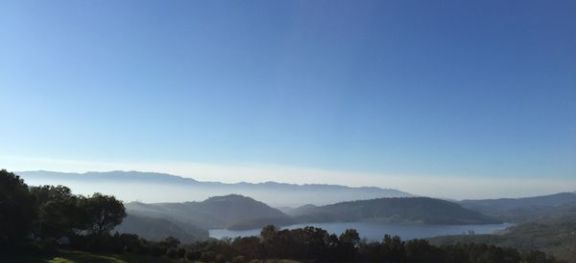A Mancunian's view of Napa


Matthew Gaughan used to work for the estimable Manchester wine retailer Hanging Ditch before his heart relocated him to Napa, where he is now a freelance wine writer and educator married to a Californian. (Incidentally, you can can read a detailed recent account of the resolution of another long-distance wine romance, this time involving Jon Bonné, in the New York Times.) Matthew took this view of Napa from Chapellet high above the valley in the east.
Within a month of my moving to Napa from Manchester in July last year, the area suffered an earthquake: literally a seismic difference from the still English ground from which I came. Also unlike the north of England, California is an area so bathed in sunshine that drought threatens the future of winemaking in the state. But it isn’t just the weather or geology I’ve found different.
The most surprising aspect is just how sommelier-led American wine culture is – 147 of the world’s 230 Master Sommeliers are North American. Sommeliers, even if it can be a catch-all term for anyone in the wine industry, command a huge amount of power and respect among the general public, their word taken as law. This respect is part of a deferential restaurant culture where service is attentive to the point of irritation: despite the drought, the server is always over your shoulder ensuring your glass of water is full to the brim.
The US has many difficult-to-understand laws pertaining to alcohol, many of them a legacy of Prohibition. One of them is the impenetrable three-tier distribution system, which governs sales from one state to another. With direct-to-consumer sales increasing, this distribution network is slowly changing but it’s still a bureaucratic mess. Other strange laws: distilleries, even those with tasting rooms, can’t sell their products to visiting customers unless the spirit is grape-based (a law that many soon change); wineries may serve food only with wine; household deliveries of alcohol have to be signed for – a difficulty when wine clubs are so popular; and even a balding 38-year-old such as myself regularly gets asked for ID.
And yet in California you can buy alcohol in a pharmacy. Such retail laws vary hugely from state to state. On a trip to Denver, I learnt that grocery chains such as Safeway can sell alcohol in only one of their stores across the whole of Colorado. Meanwhile, in neighbouring Utah, it is only possible to buy an alcoholic beverage with food, and the desperate drinker is limited to ordering one drink an hour.
Some stereotypical beliefs about the Napa Valley are certainly true. Every single vineyard worker is Mexican. The price of the wines in relation to their quality is often difficult to justify, and generally only affordable to the luxury-addled consumer. Tasting rooms charge up to $50 for a tasting flight, per person. Limousines line Highway 29 and the Silverado Trail, the Valley’s two main arteries decked with grandiose architectural statements: go big or go home is the California motto.
Although those in the California wine industry like to boast of its rich history (and there is certainly plenty of it), wine culture is still young. Consumers generally buy on varietal, but sales of red blends are increasing. Generic wines somehow survive: brands such as Korbel and Barefoot label their bubbly as California Champagne, and supermarkets carry jug wines sold as Burgundy as well as California Sherry, Port and Madeira. It’s difficult to find quality South African or Australian wine, though Yellow Tail, a brand expressly designed for the American market, is ubiquitous at $5 a bottle.
But being in California at the moment is exciting for many reasons. The character of different vineyards is constantly being discovered; Pinot Noir from Sonoma and Mendocino is emerging as some of the most thrilling wine in the States; Paso Robles makes white Rhône blends better than the Rhône does itself; and Zinfandel is finding a new lease of life. Given the availability of great French, Italian, and Spanish wine, there’s nowhere else I’d rather be right now.
Become a member to view this article and thousands more!
- 15,406 featured articles
- 274,946 wine reviews
- Maps from The World Atlas of Wine, 8th edition (RRP £50)
- The Oxford Companion to Wine, 5th edition (RRP £50)
- Members’ forum
- 15,406 featured articles
- 274,946 wine reviews
- Maps from The World Atlas of Wine, 8th edition (RRP £50)
- The Oxford Companion to Wine, 5th edition (RRP £50)
- Members’ forum
- Commercial use of our Tasting Notes